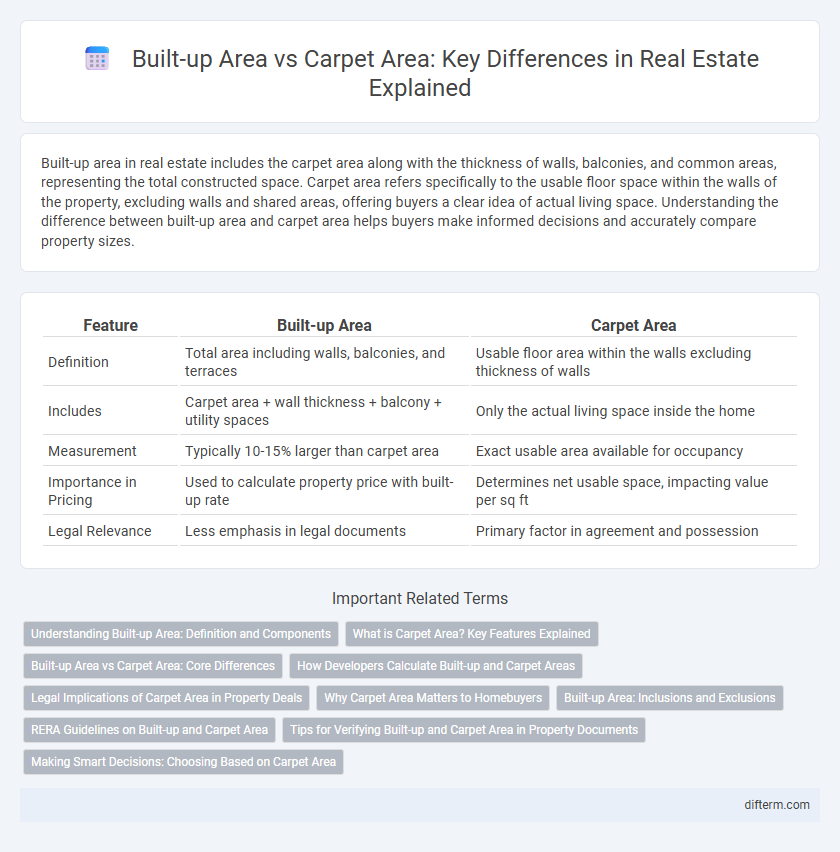Built-up area in real estate includes the carpet area along with the thickness of walls, balconies, and common areas, representing the total constructed space. Carpet area refers specifically to the usable floor space within the walls of the property, excluding walls and shared areas, offering buyers a clear idea of actual living space. Understanding the difference between built-up area and carpet area helps buyers make informed decisions and accurately compare property sizes.
Table of Comparison
| Feature | Built-up Area | Carpet Area |
|---|---|---|
| Definition | Total area including walls, balconies, and terraces | Usable floor area within the walls excluding thickness of walls |
| Includes | Carpet area + wall thickness + balcony + utility spaces | Only the actual living space inside the home |
| Measurement | Typically 10-15% larger than carpet area | Exact usable area available for occupancy |
| Importance in Pricing | Used to calculate property price with built-up rate | Determines net usable space, impacting value per sq ft |
| Legal Relevance | Less emphasis in legal documents | Primary factor in agreement and possession |
Understanding Built-up Area: Definition and Components
Built-up area refers to the total constructed area of a property, including the carpet area along with the thickness of external walls, balconies, and common spaces. It encompasses both usable living space and structural elements, typically resulting in a figure 10-20% larger than the carpet area. Understanding built-up area helps buyers gauge the complete size of a property beyond just the interior usable space.
What is Carpet Area? Key Features Explained
Carpet area refers to the actual usable area within the walls of a residential or commercial property, excluding the thickness of inner walls and common spaces like balconies and lobbies. Key features include its direct impact on property valuation and utility, as it defines the living space available to occupants. Understanding carpet area is crucial for buyers to compare property sizes and calculate the true cost per square foot accurately.
Built-up Area vs Carpet Area: Core Differences
Built-up area includes the carpet area along with the thickness of walls, balconies, and common areas, making it larger than the carpet area which only covers the usable floor space within the walls of an apartment. Carpet area is the actual area available for living and measuring it is crucial for understanding the real size of the property you can utilize. Understanding the distinction between built-up and carpet areas influences property valuation, purchase decisions, and legal clarity in real estate transactions.
How Developers Calculate Built-up and Carpet Areas
Developers calculate built-up area by including the carpet area plus the thickness of internal and external walls, balconies, and other usable spaces, often resulting in a 15-30% larger measurement than carpet area. Carpet area refers strictly to the actual usable floor space inside the walls where a carpet can be laid, excluding walls and common areas. Understanding these calculations helps buyers assess the true livable space versus the total constructed area represented in their property documents.
Legal Implications of Carpet Area in Property Deals
Carpet area represents the actual usable floor space inside a property, excluding walls and common areas, making it a critical factor in legal agreements and property valuation. Legal regulations, such as the Real Estate (Regulation and Development) Act (RERA) in India, mandate disclosure of carpet area to ensure transparency and protect buyer rights. Accurate representation of carpet area in sale deeds prevents disputes, aids in clear taxation, and establishes rightful ownership boundaries in property deals.
Why Carpet Area Matters to Homebuyers
Carpet area represents the actual usable floor space within the walls of a property, excluding common areas, making it a crucial factor for homebuyers seeking accurate assessments of living space. Unlike built-up area, which accounts for walls and balconies, carpet area provides a transparent measure of the space available for furniture placement and daily activities. Understanding carpet area helps buyers make informed decisions based on functional space rather than inflated size metrics, ensuring value for their investment.
Built-up Area: Inclusions and Exclusions
Built-up area includes the carpet area along with the thickness of walls, balconies, terraces, and utility shafts, representing the total constructed area of a property. It excludes spaces like common areas, lift shafts, and open parking, which are not part of the individual unit's built structure. Understanding built-up area is crucial for accurate property valuation and comparing real estate offerings.
RERA Guidelines on Built-up and Carpet Area
RERA guidelines define built-up area as the total area covered by the apartment, including walls, balconies, and utility spaces, while carpet area refers to the actual usable floor space within the walls. Developers must clearly disclose these measurements to buyers under RERA regulations to ensure transparency in property transactions. Accurate representation of built-up and carpet areas protects consumer interests and standardizes real estate marketing practices.
Tips for Verifying Built-up and Carpet Area in Property Documents
Verify the built-up area and carpet area in property documents by cross-checking the sanctioned building plans approved by local authorities, ensuring measurements align with legal approvals. Request a professional surveyor to assess the physical dimensions of the property and compare them with the documented built-up and carpet areas. Pay close attention to exclusions such as common areas, balconies, and walls in carpet area calculations to avoid discrepancies in property valuation.
Making Smart Decisions: Choosing Based on Carpet Area
Carpet area represents the actual usable floor space within a property, excluding walls, balconies, and common areas, making it a more accurate metric for assessing living space. Understanding carpet area helps buyers make smart decisions by focusing on the functional area they will occupy, rather than inflated built-up area figures that include non-usable spaces. Prioritizing carpet area ensures better value for money, efficient space planning, and transparent comparisons among real estate listings.
Built-up Area vs Carpet Area Infographic

 difterm.com
difterm.com